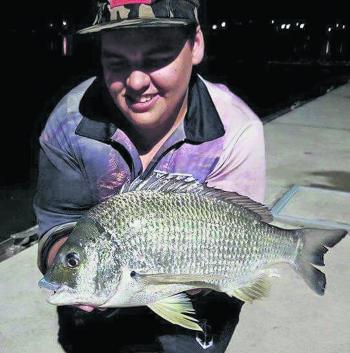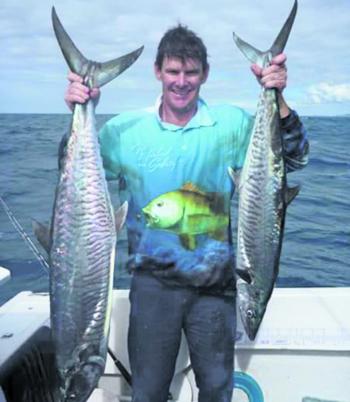Barramundi season is now open, and in addition to this great news, all reefs and estuaries have produced excellent fish to celebrate. Several people have asked me to write about closer inshore options for smaller boats, for those who don’t have time for the longer trips to the reef, so this month I’ve included a few options below for fishos to consider on their next run out in the boat.
Rundle Island is accessed via the coast line north and is around a 30-minute trip exiting the northern end of Facing Island at about 25 knots – that is, provided you don’t take advantage of the common boil ups from pelagics along the way! The Island itself is surrounded by rocks, bommies, deep holes, coral and many sandy strips, which gives anglers plenty of opportunity to catch both reef, rock species, and hard running pelagic specimens. The North Eastern corner is known for great runs of mackerel, which have been caught floating or slow retrieving pilchards. Troll the Island end to end in the early morning. A dawn arrival is best, or an hour before dusk. The occasional coral trout can be caught on this end, along with trevally, cod and sweetlip.
Big jew inhabit the South Western Side of the Island; there is a sandy shelf where jew school after decent rain. Live baits are brilliant but when they are feeding any bait will suffice.
The Shoals are SSE of Rundle, very close to the coast, and feature bommies and lots of rocky grounds to explore. Rock Cod Shoals early morning and late afternoon is best for this small area, and drifting seems to produce the best hook-up rates. This reef is renowned for sharks in the warmer months of the year.
Jig silver lures, troll the area or bottom bash with bait and you will catch fish. Snapper are a common catch here in certain months of the year both squire and nobbies. I have caught nannygai, blubber-lip and good-sized spangled emperor there. I have looked for accurate marks on the Shoal but find that sounding out the area is the best method to find the bommies I want to target according to the species I want to find.
The grounds around the southern end of Facing Island provides a multitude of fishing options, and most locals who hit this area fish for queenfish, mackerel and tuna. Northerly winds makegreat fishing conditions as there is not a lot of protection from the elements and anyone who has fished through the harbour and exited to the reefs this way will know it can be uncomfortable at times. Troll the edges of the channel and through the channel markers in the early morning for the best results. There can be a lot of smashing on the surface and bird activity, so finding these fish shouldn’t be too difficult! If there isn’t much activity, go back to your sounder and you will find them. There are quite a few rocky outcrops along Gatcombe which produce good grunter, parrot and the odd trout, just watch the run, which will get snagged all day – although a standard part of fishing, this can be frustrating. Check out Oyster Rocks as well.
The Bindaree Wreck is well known to the locals, and can be accessed by smaller boats. The wreck is northeast of the northern entrance of Facing Island, and the marks can be found on all GPSs so you shouldn’t have any trouble finding it. A small wreck of a trawler around 18m long and sits down around 10m of water. The area produces quality fish; I have caught cobia, mackerel, trevally and parrot as well as good jew. Bindaree is a small area so it’s best to fish on the outgoing tide and to cast on or near the wreck from the western side. Float baits and troll to get good results. If you approach and see a multitude of boats (seven or more) don’t waste your time, as there won’t be enough room.
I will feature some more options next month for people to consider other than reef and estuaries.
Over the past months all reefs have produced the usual suspects such as trout, sweetlip, parrot and the like. We’ve experienced some hit and miss occasions, but mostly it’s not difficult to get a feed. I’ve found the incoming tide works better than the outgoing. I am normally a big advocate for drifting, however if you find the fish, anchor up because on the second and third drift the bite has gone. Maximise your chances even if you only get the bite for a short space, at least you know it is there.
I must say the pelagics have fired up recently; North West still gives up great mahimahi, marlin and some cracking Spanish mackerel, skirted lures have done the damage for those who target these big pelagics. I have seen a few Spanish macks succumb to bottom bouncing baits, and all around there have been smiling anglers. You will find the mackerel and tuna over all the reefs, the coastline and some cracking fish around the southern end of Facing Island.
Calliope River produces good-sized mangrove jack. I would love to be able to pinpoint a spot for you to try, but we have caught them all the way from the upper reaches almost to fresh water right through to the mouth of the river, so drop a line in anywhere. Try ZMan in Pearl; these lures smash the jacks and land the odd grunter. Work the structure, rocky ground and mangroves and you will find them – the top of the tide works best.
Boyne River has similar results, however catches of flathead seem to have quietened off a little. Queenfish have reported for duty at the bridge between Boyne and Tannum, and dart seem to be an excellent target around the mouth. They are great for the kids and a whole lot of fun.
Tight lines everyone, and hopefully I will hear of some more brilliant catches over the month.
Reads: 4929

Steve Sharman caught a great bag of metre plus Spanish casting metal slugs around Bindaree Wreck.






